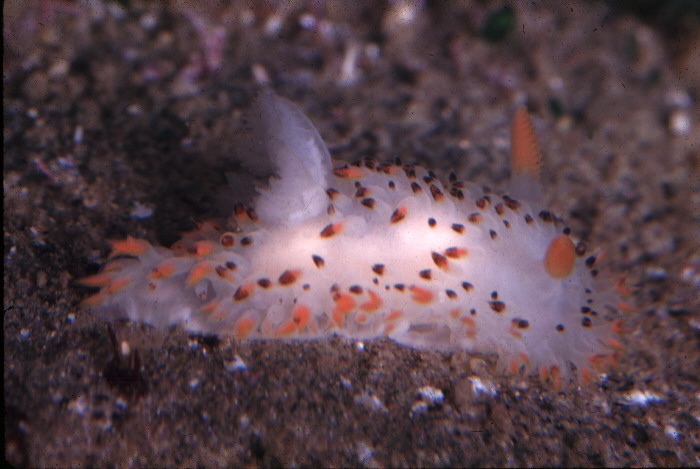 |
Photo courtesy of Dr. Wes Farmer
Specimen collected at Point Loma Lighthouse tidepools, San Diego, Calif, circa 1972
Crimora coneja
Crimora coneja Marcus, 1961
Crimora coneja is a delicate and rarely seen dorid nudibranch with orange rhinophores, white gills, and pointed, orange and brown tipped dorsal papillae, some of which have forked tips. Specimens can reach 23 mm in length.
Crimora coneja is known from Point Loma in San Diego, California to Cape Arago, Oregon. However, it has been reported from only two localities between these two sites: (1) in the rocky intertidal at Punta Gorda, Humboldt County, California (Goddard, 1987), and (2) subtidally on rocks just inside the mouth of Morro Bay (M. Behrens, personal communication, June 2000). Crimora coneja has been found in abundance only once, in 1984 at Punta Gorda, when 66 specimens were found on a single low tide.
In the northern part of its range Crimora coneja preys exclusively on the thinly encrusting bryozoan Hincksina minuscula, which is usually found in cryptic habitats on the undersides of loose rocks and in small holes and crevices. Its prey at Point Loma is unknown. Crimora coneja uses its radula to rasp entire zooids out of their minute calcified compartments, leaving behind the lacey white skeleton of the bryozoan.
The egg mass of Crimora coneja is a thin white ribbon laid flat, rather than on edge like most other dorid nudibranchs. Planktotrophic veliger larvae hatch from these egg masses after 10 days at 12 to 16 degrees C (Goddard, unpublished observations) and 17 days at 10 to 14 degrees C.
In both form and color, Crimora coneja superficially resemble Triopha catalinae (Cooper, 1863) and, to a lesser degree, Laila cockerelli MacFarland, 1905. These species may form a Mullerian mimicry complex capable of advertising their mutual distastefulness to visual predators like fish.
Why Crimora coneja has not been found at more localities in California is something of a mystery, and divers especially should keep an eye out for this exquisite species.
References:
Goddard, J.H.R. 1984. The opisthobranchs of Cape Arago, Oregon, with notes on their biology and a summary of benthic opisthobranchs known from Oregon. The Veliger 27(2):143-163.
Goddard, J.H.R. 1987. Observations on the opisthobranch mollusks of Punta Gorda, California, with notes on the distribution and biology of Crimora coneja. The Veliger 29(3):267-273.
Taxonomic Information courtesy of Dr. Jeff Goddard

|
Dr. Jeff Goddard |
